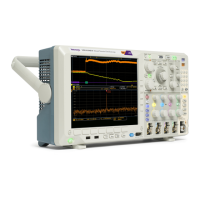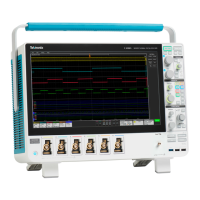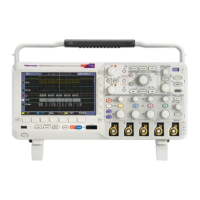Specifications
Table 4: Trigger s pecifications (cont.)
Pulse class Minimum
pulse width
Minimum rearm time
Glitch
4ns
2 ns + 5% of glitch width setting
Runt 4 ns 2 ns
Time-qualified runt
4ns
8.5 ns + 5% of width setting
Width 4 ns
2 ns + 5% of width upper limit setting
Slew rate (transition time)
4ns
8.5 ns + 5% of delta time setting
Pulse type trigger, minimum pulse,
rearm time, transition time
For the trigger class w idth and the trigger class runt, the pulse width refers to the width of the
pulse being measured. The rearm time refers to the time between pulses.
For the trigger class s lew rate, the pulse width refers to the delta time being measured. The
rearm time refers to the time it takes the signal to cross the two trigger thresholds again.
Transition time trigger, delta time
range
4nsto8s
Time range for glitch, pulse width,
timeout, time-qualified runt, or
time-qualified window triggering
4nsto8s
Time Range Accuracy
1 ns to 500 ns
±(20% of setting + 0.5 ns)
Time Accuracy for Pulse, G litch,
Timeout, or Width Triggering
520 ns to 1 s
±(0.01% of setting + 100 ns)
B trigger after events, minimum
pulse width and maximum event
frequency, typical
4 ns, 500 MHz
B trigger, minimum time between
arm and trigger, typical
4ns
For trigger after time, this is the time between the end of the time period and the B trigger
event.
For trigger after events, this is the time between the last A trigger event and the first B trigger
event.
B trigger after time, time range
4 ns to 8 seconds
B trigger after events, event range
1 to 4,000,000
Source
Range
Any input channel
±8 divisions from center of screen
±8 divisions from 0 V when vertical LF reject
trigger coupling is selected
Aux In (External)
±8 V
Line Not applicable
Trigger level ranges
Line trigger level is fixed at about 50% of the line voltage.
This specification applies to logic and pulse thresholds.
MSO4000B and DPO4000B Series Specifications and Performance Verification 15

